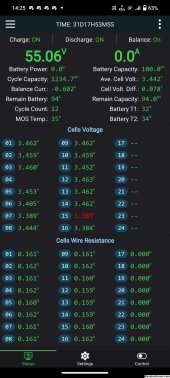Some background:
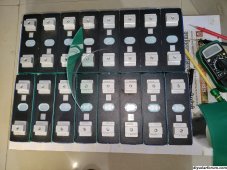
I built my own LFP battery consisting of 16 CALB L160F100 with the JK-BD6A24S10P paired to a LuxPowerTek SNA 5k unit.
It is 50 days old showing 21 cycle counts on the BMS as of 26 Oct 2023.
It took the battery (51.2V, 100 Ah, 0.6 A active balance current) a full month to finally be balanced. I was forced to wait this long because I didn't had access to a DC Power Supply for top balancing before putting the battery together. I basically waited for them to become top balanced everyday after being fully charged. I realized early that the only way for the cells to come in balance was at the end of charge and the inbuilt BMS balance start setting was kicking too early. So, I changed it to 3.45 V as 'recommended' here.
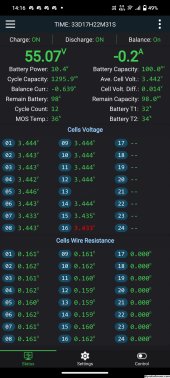
1. Battery coming in balance at the end of 33rd day
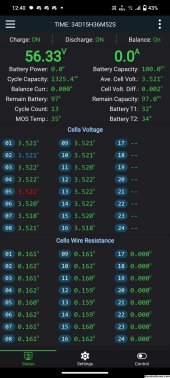
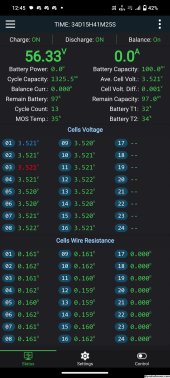
Two images showing the battery balanced at 3.52 V with Cell deviation down to 0.003 V (5 minutes apart). Please try to ignore the current counter and contain your cringe if you already know where this is going!!
Just like everybody else in this forum I too began with the 'recommended' bulk around 3.5 ish per cell and then float at 3.4V/Cell because JK BMSes (with the exception of recently announced Industrial style JK-PB_A__S__P models) do not communicate with inverter unless you figure out a DIY solution. I also watched many videos on repeat from Off-Grid garage and Will Prowse before arriving at these settings just to be sure I wasn't really 'missing' anything. Turns out I was.
The balancing problem that (almost) everyone faces:
The problem that I faced was the same as everybody else faces here: Cells no longer in balance (showing 0.040 V deviation) even after a 'full charge' to 3.5V the very next day. (you will soon realize the reason behind these quotes later)Clearly, If I was doing everything 'right' according to what everyone on the internet is doing my cells should retain their balance at least.
Overtime, people have tried to attack this problem by saying passive balancing simply isn't enough and how there is basically a need for active balancing to be the default offering in all BMS's in order to keep the cells in 'daily' balance.
Overtime, this has resulted in the demand for higher Active Balance Current in BMS's.
All this time I kept thinking something was 'off' about my BMS and the way it was estimating SOC. But surely the current tapering at the end of each charge was there. If I was charging my battery correctly (at a modest solar 0.2C to 0.25C rate) and it's reading the same charger voltage, all the cells should reach the same voltage at the same time after being top-balanced. But that clearly wasn't the case.
So I basically made up my mind next to figure out Inverter-BMS communication and possibly replacing the BMS if that wasn't possible. Long story short, I was watching DIYBMS videos and stumbled across one particular video about 'floating' lithium cells -
Charging Marine Lithium Battery Banks | Nordkyn Design
 nordkyndesign.com
nordkyndesign.com
It clearly states this about Standard Charge Model for the L160F100 Cell:
Put very simply, when it comes to LiFePO4 cells there are only two charge phases - CC and CV at 3.65V max (Bulk not exceeding 0.5C after absorb with Current termination at 0.05 C or below, but never ZERO! dependent on particular LFP chemistry). The Cells simply rest (not float) after charging until the voltage drops enough for the next charging cycle to begin.At room temperature (25 ± 2°C), charged to 3.65V at a constant current of 50A, and then, changed continuously with constant voltage of 3.65V until the current was not more than 5±0.5A.
Needless to say, I immediately implemented this the very next day. And in the absence of inverter communication, it is exactly how you think it went - by literally staring at cell voltages for around half an hour and then changing the charge controller voltage when the current starts tapering.
And it finally gave me exactly what I wanted to see - basically fully charged (98-99% SOC) battery resting at around 3.37 V/Cell balance to within 0.010 V.
(The battery is almost charged close to 98 % but the BMS reading keeps drifting over time)

And just to truly verify Nordkyn, I also turned off charging after 78% and 84% SOC and checked that the voltage indeed came down and stabilized to below 3.37V. (Note the Charge MOS OFF state below). Indeed, LFP is fully charged approaching 3.38 V. It simply overcharges at voltages above that.
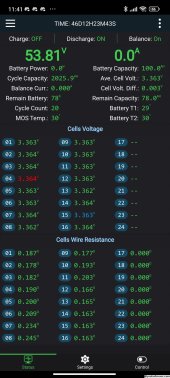

Takeaways from my mistake:
Settings that I now personally use:56.2 V (~3.51 V/Cell) as my charging voltage. You need to determine this the opposite way. Aim for a charging voltage that keeps all cells below 3.6V with the max current possible by your setup (within 0.5C whatever you prefer). And then terminating charge as soon as the current starts tapering. I'm not losing much in capacity by waiting for it to drop down to 0.05C anyways. You can always look up charge termination for your voltage and LFP chemistry from Nordkyn's article if you want.
'float' at 54 V (3.375V/Cell). Going above 54.2V for float is discouraged.
Want to 'baby' the cells? float all the way down to 53.6V after charge termination.
If you already have industrial style BMS communication, it is most likely to be configured already.
Things to NOTE:
- There is no such thing as ideal charge voltage for LFP. It is like asking an entirely wrong question basically. Any and all answers are wrong!
- Charge termination is the ONLY way to safely charge LFP within a reasonable time frame. Using 3.38 V works but will take basically forever to absorb.
- NEVER let the Cells
sit/float'run out of free lithium and electroplate' harming their balance by keeping them at voltages higher than 3.4 V with no current flowing for hours. - Battery BMS and Inverter communication is the only way to tell your Inverter to stop charging. DO NOT terminate charge by using BMS controls. Adjust charge controller settings instead. A BMS is designed to be the last-resort protection device of your system. It is not a charge controller.
- It basically means, A BMS advertised for Lithium batteries must be able to signal the charge controller to stop charging based on measured current. A BMS without comms can not be reasonably termed as lithium BMS.
- There is simply no point of balancing while the Cell is charging/discharging and accepting current. Each cell will have a slightly varying internal resistance. Balancing should only be done when the cells are fully charged and the voltage has stabilized (termed OCV).
And there is simply no point using voltages higher than 3.4 V for active balancing. The amount of discussion this forum has witnessed around 'the ideal balance voltage' notwithstanding.
With the correct charging method outlined in this post - your cells will inherently self balance as long as no cells becomes defective. Even after more than two days of charging like this - my cells have never needed to balance. Balancing is entirely off on my BMS for now and it will stay that way unless the pack deviates.
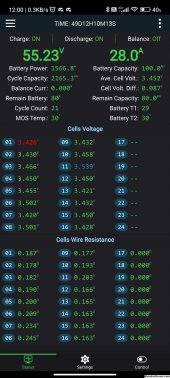
No need to turn balancer on at this phase of charging. The cell voltages are all over the place because of their internal resistances. Just make sure no Cell exceeds the 3.6V limit. Update: Cell 11 was retightened
I keep reading about people wanting to know about 'babying' their cells. I'm even aware of the exact thread in this forum because I too tried doing exactly that. But LFP simply works differently from Lead Acid batteries.
The latter is charged while the former is charge terminated !!
All in all, in hindsight, I realized that I have imparted very imperceptible amounts of irreversible damage to some of my cells. It is very minor but it is still something that I will look forward to prevent entirely in my next battery build!
Not being able to implement what I say probably won't rapidly fail your battery quickly either. It is just that the chemistry is so incredibly resilient and forgiving that most of you probably aren't going to notice it. Not to mention most users fail to even accumulate close to 1500 cycles in their battery's lifetime anyway where it should start to matter.
I hope this article simplifies many things related to LFP charging. Eliminated existing doubts regarding charging and balancing and created newer ones.
Caveat:
Everything described in this post only applies after initial top-balancing has been done. There is no point implementing anything from this article if your battery is not balanced. Balancing is a pre-requisite.Attachments
Last edited:



